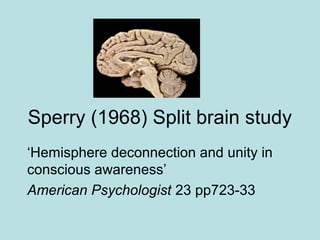Sperry (1968) split brain study
•Télécharger en tant que PPT, PDF•
8 j'aime•25,365 vues
Signaler
Partager
Signaler
Partager

Recommandé
Recommandé
Contenu connexe
Tendances
Tendances (20)
Neurobiology of attention deficit hyperactivity disorder

Neurobiology of attention deficit hyperactivity disorder
Similaire à Sperry (1968) split brain study
Similaire à Sperry (1968) split brain study (20)
The Brain - Part 6 of Piero Scaruffi's class "Thinking about Thought" at UC B...

The Brain - Part 6 of Piero Scaruffi's class "Thinking about Thought" at UC B...
The Brain - Part 6 of Piero Scaruffi's class "Thinking about Thought" at UC B...

The Brain - Part 6 of Piero Scaruffi's class "Thinking about Thought" at UC B...
Dernier
Dernier (20)
Sensory_Experience_and_Emotional_Resonance_in_Gabriel_Okaras_The_Piano_and_Th...

Sensory_Experience_and_Emotional_Resonance_in_Gabriel_Okaras_The_Piano_and_Th...
Python Notes for mca i year students osmania university.docx

Python Notes for mca i year students osmania university.docx
This PowerPoint helps students to consider the concept of infinity.

This PowerPoint helps students to consider the concept of infinity.
HMCS Vancouver Pre-Deployment Brief - May 2024 (Web Version).pptx

HMCS Vancouver Pre-Deployment Brief - May 2024 (Web Version).pptx
Unit 3 Emotional Intelligence and Spiritual Intelligence.pdf

Unit 3 Emotional Intelligence and Spiritual Intelligence.pdf
Fostering Friendships - Enhancing Social Bonds in the Classroom

Fostering Friendships - Enhancing Social Bonds in the Classroom
ICT role in 21st century education and it's challenges.

ICT role in 21st century education and it's challenges.
Salient Features of India constitution especially power and functions

Salient Features of India constitution especially power and functions
Micro-Scholarship, What it is, How can it help me.pdf

Micro-Scholarship, What it is, How can it help me.pdf
HMCS Max Bernays Pre-Deployment Brief (May 2024).pptx

HMCS Max Bernays Pre-Deployment Brief (May 2024).pptx
UGC NET Paper 1 Mathematical Reasoning & Aptitude.pdf

UGC NET Paper 1 Mathematical Reasoning & Aptitude.pdf
Jual Obat Aborsi Hongkong ( Asli No.1 ) 085657271886 Obat Penggugur Kandungan...

Jual Obat Aborsi Hongkong ( Asli No.1 ) 085657271886 Obat Penggugur Kandungan...
Unit-V; Pricing (Pharma Marketing Management).pptx

Unit-V; Pricing (Pharma Marketing Management).pptx
Sperry (1968) split brain study
- 1. Sperry (1968) Split brain study ‘Hemisphere deconnection and unity in conscious awareness’ American Psychologist 23 pp723-33
- 2. Sperry (1968) Split brain study introduction • brain has 2 hemispheres • connected by commissural fibres • lateralisation of function – each has different functions – cognitive / motor • split to treat extreme epilepsy
- 3. Sperry (1968) Split brain study
- 5. Sperry (1968) Split brain study the studies: subjects • 11 'most radical disconnection' • 2 benefited; others 'recent'
- 6. Sperry (1968) Split brain study designs: natural experiments • variables occur 'naturally • e.g. socio-economic- but in this case surgical procedures • carefully controlled tests • also case studies • open ended interviews etc
- 7. Sperry (1968) Split brain study procedure • one hand feeling unseen objects • attention to one ‘visual field’ • image shown for 1/10th sec (to prevent eyes moving to prevent use of other visual field) • 2 images shown for 1/10th s; one to each field • etc
- 8. Sperry (1968) Split brain study results: visual test 1 • subject show image in one visual field • recognised if in that field before • not recognised if re-shown in other field
- 9. Left visual field Right visual field
- 10. Sperry (1968) Split brain study results: visual test 2 • RH subjects shown objects in each field • could describe object in R field • said no object in L field, or ‘just a flash' • able to respond non-verbally (pick up object with L hand) to object in L field
- 12. Sperry (1968) Split brain study results: visual / drawing test • 2 objects shown 1in LVF, 1RVF • drew object with shielded L hand • reported they had drawn object in R field!
- 13. they could draw, When asked to with the left say what they hand, the object had drawn they (e.g. pen) that would name the had been object shown to presented to their their RVF (e.g. LVF. banana)!
- 14. Sperry (1968) Split brain study results: tactile test • objects in R hand => verbal description • object in L hand => only NV response • L hand unable to respond to stimulus in R hand
- 15. Patients would feel one object with each hand When they felt When they felt and object with and object with the left hand the right hand patients could patients could not name object name the object (but could identify it non- verbally, by Left handitcould picking out from a group) not respond to what the right hand felt
- 16. Sperry (1968) Split brain study results: 'competing tasks' • R and L hand had different tasks • could do both at same time • non-split brain subjects slowed by this • only useful for odd lab tasks!
- 17. Sperry (1968) Split brain study discussion: Sperry’s conclusions • apparent doubling of most areas of conscious awareness • hemispheres appear unaware of each other • easier to think of two hemispheres as two people
- 18. Sperry (1968) Split brain study discussion: not a simple tale! • R side could (literally) tell L side what it knew! • in lab had to be prevented from talking • = sides not so isolated • so personality / intelligence effects limited • some STM / concentration difficulties
- 19. Sperry (1968) Split brain study discussion • difficult to generalise! • variation even between only 11 subjects